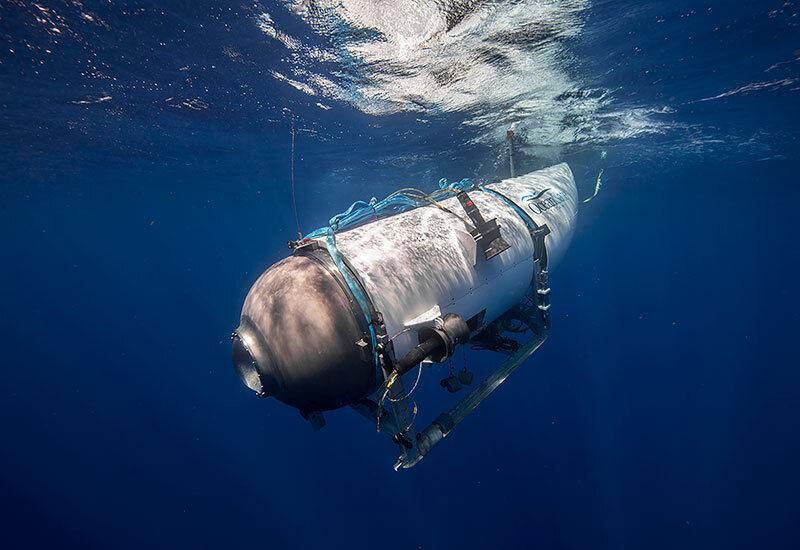Since the disappearance of the submersible was confirmed Titan in the Atlantic on Sunday, planes have been combing the ocean for it beneath the waves.
The US Coast Guard announced Wednesday that a Canadian P-3 aircraft had identified unexplained underwater noiseswith apparent blows at half hour intervals.
LOOK: Why it is not possible to determine exactly how long the oxygen will last in the Titan submersible
The signal continues to be investigated and analyzed, authorities said.
How can planes flying above the waves detect something so deep underwater?
Seeking submersible it is traditionally the exclusive work of some of the largest and most technologically advanced aircraft in any air force.
Often based on civilian designs, these machines display an impressive suite of sound sensors to locate military submarines under the sea.
It is usually a game of cat and mouse between planes and submarines that want to stay hidden. That is not the case now.
The fact that these aerial hunters are packed with new advanced technology would seem to give them an advantage.
However, as the lost titansubmersibles remain very difficult to find, especially at depths of 3,800 meters, where the remains of the titanic.
Regular hits every 30 minutes
The four-engine turboprop P-3 Orionwhich detected the mysterious thumping noise on Wednesday, first entered service in 1962 and is based on the Lockheed Electra airliner.
The aircraft identified the noise after dropping sonar buoys, which floated on the surface and detected sounds that nature probably would not make.
He caught a noise regular hits every 30 minutessomething that experts suggest is a sign that they are being made by humans.
“The fact that the acoustic noises are 30 minutes apart is a great sign,” said Jamie Pringle, a professor of forensic geosciences at Keele University in the UK.
“Acoustic noise travels far in the water, so that’s good news and bad news. You would need (at least) three of those static buoys to be able to triangulate the sound source to get a fix,” he added.
The Lockheed P-3 Orion is also equipped with magnetic anomaly detectors, which find small disturbances in the Earth’s magnetic field caused by metal walls of submarines.
If an aircraft equipped with the detectors flies over a large mass of metal within its detection range, it will find it.
The presence of a known wreck of a large steel-hulled vessel such as the Titanic makes it difficult to use this technique.
Boeing P-8 Poseidon, the world’s most advanced maritime patrol vessel
The P-3 is not the only aircraft involved in the search.
Others that travel the Atlantic include the C-130 Hercules and the relatively new Boeing P-8 Poseidonknown as the world’s most advanced maritime patrol vessel.

The Poseidon looks familiar because he is. This aircraft is a derivation of the passenger plane Boeing 737.
The range of the Poseidon is much shorter than that of the P-3: 2,250 kilometers versus 9,000 kilometers. However, it can fly 3,600 meters higher, and faster too.
Like a game of battleships, the crew of the Poseidon uses a grid pattern to figure out where a submersible isn’t, then zoom in on where it might be.
It does this by deploying one of the most effective ways to track a submarine: sonobuoy fields.
Fired by parachute from a high-altitude rotary launcher, Multi-Static Active Coherent (Mac) buoys generate multiple sonar pulses over time to last longer and extend their search range.
The arrangement of buoys like these is one of the best kept secrets in anti-submarine warfare. A single P-8 can deploy more than 120 buoys.
Along with these buoys, the Poseidon uses a full suite of technology including its own acoustic sensor, synthetic aperture radar to detect, classify and track surfaced submersibles, and long-distance periscope detection.
It also features an electro-optical/infrared turret that can identify submersible exhaust, an electromagnetic sensor particularly useful for tracking the positions of radar emitters, and even a hydrocarbon tracking system to “sniff out” the presence of military submarines with diesel and electric motor.

However, the Poseidon flies too high to use magnetic anomaly detection effectively, and instead UAVs equipped with these detectors are being developed to take off from their sonobuoy tubes.
What hasn’t changed, even for the most advanced aircraft, is the reliance on traditional intelligence.
“To be as effective as possible, the P-8 first needs to have a rough idea of the location and direction of the sub in order to find it,” says Sirharth Kaushal, a researcher at the UK’s center for defense and security studies, the Royal United Services Institute (RUSI).
In a military search, this “rough sense” is based on intelligence gathered from signals, satellite imagery, interpersonal contact, and ever-growing networks of hydrophones placed on the ocean floor, often at “bottlenecks,” to detect when submersibles pass over them.
But in the case of the missing Titan submersible, such clues are few and far between.
Perhaps one of the most important capabilities of the Poseidon, and one that distinguishes it from the Orion, is that it functions as a communications hub, a “node” if you will, at the center of a network of ships, UAVs equipped with sensors. , and unmanned surface ships that will in effect multiply their power.

This interconnected power has led some analysts to believe that the advent of aircraft like the Poseidon is ushering in an era in which the sea becomes “transparent” and submarines will find it impossible to hide.
But while Orion’s and now Poseidon’s technologies and capabilities make it seem like they’re ahead of the curve, they do have their limitations.
Sonde pulses, for example, can face interference from different layers of temperature and salinity in the water. A submersible can be hidden under these.
Magnetic sensing technology tends to have a short range: it only finds submersibles that are close to the surface and close to the aircraft’s position.
And submersibles can also avoid detection by staying hidden in the “ambient water noise” of the ocean.
The P-8 may be the world’s most advanced submarine hunter. But as independent defense analyst HI Sutton told the BBC, “Systems like Poseidon will still need to know where to look.”
The truth is that finding a submersible can also be a matter of luck. After all, it was the 60-year-old P-3 Orion that detected the explosions that could come from the missing Titan.
Mark Pising
BBC Future
Source: Elcomercio
I am Jack Morton and I work in 24 News Recorder. I mostly cover world news and I have also authored 24 news recorder. I find this work highly interesting and it allows me to keep up with current events happening around the world.

:quality(75)/cloudfront-us-east-1.images.arcpublishing.com/elcomercio/3BVFYSV2IZHG5DSLOMZPBY2IH4.jpg)



:quality(75)/cloudfront-us-east-1.images.arcpublishing.com/elcomercio/BUNML4TQNVHSBOBMY5FC3QEM2M.jpg)

